The Silver Sliver Galaxy is an unbarred spiral galaxy located approximately 27.3 million light-years away in the constellation Andromeda. With an apparent magnitude of 10.8, it can be observed in amateur telescopes. The galaxy is catalogued as NGC 891 in the New General Catalogue and Caldwell 23 (C23) in the Caldwell catalogue. It is also known as the Outer Limits Galaxy.
NGC 891 is one of the finest edge-on galaxies in the sky. It has an apparent size of 13.5 by 2.5 arcminutes, corresponding to a physical diameter of about 100,000 light-years. The galaxy contains about 500 billion stars.
The Silver Sliver Galaxy gives us an idea of what our own galaxy, the Milky Way, would look like when seen edge-on. The two galaxies are believed to be similar in size and luminosity, but NGC 891 has a higher global star formation rate. The galaxy harbours an H II nucleus.
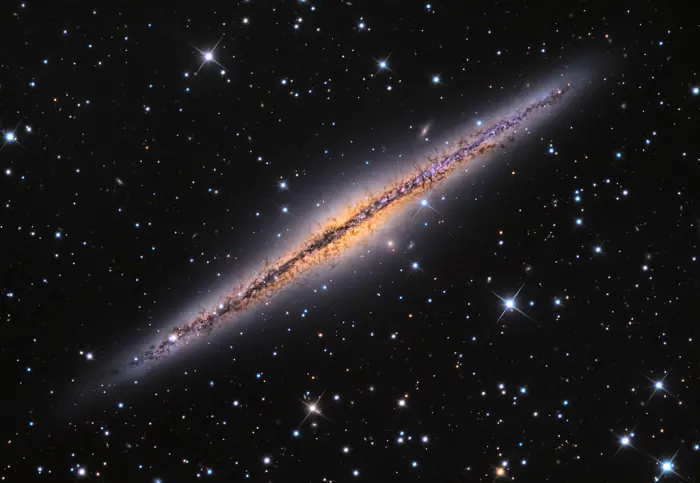
The Silver Sliver Galaxy (NGC 891), image credit: Adam Block/Mount Lemmon SkyCenter/University of Arizona (CC BY-SA 3.0)
In 1995, a team of astronomers mapped the galaxy’s central region using the IRAM 30m telescope on the Pico Veleta in Sierra Nevada in Spain. They found that the kinematics of the molecular gas in the galaxy’s inner regions was highly distorted. They explained the dynamics of molecular hydrogen with the presence of a central bar. However, the galaxy is usually classified as an unbarred spiral.
The galaxy’s disk was found to show unusual filamentary patterns that extend into the halo, away from the disk. The interstellar dust is thought to have been ejected by supernova events in the galaxy. An alternative explanation is that the features are the product of the light pressure from the nearby stars.
Observations with NASA and ESA’s the Hubble Space Telescope (HST) have revealed that the halo of the galaxy contained mostly very old stars. These stars are grouped in globular clusters.
In 2010, a study found 125 planetary nebulae in NGC 891, which allowed astronomers to study the motions of different populations of stars in the galaxy. Scientists have identified two possible stellar streams that may be the remnants of mergers with smaller companions.
Observations with the James Webb Space Telescope (JWST) in 2024 allowed astronomers to detect dust emission extending out to 13,000 light-years from the Silver Sliver’s galactic disk. A team led by Jérémy Chastenet of the Ghent University in Belgium observed NGC 891 with James Webb’s MIRI and NIRCam instruments. They found the dust emission in the form of arcs, filaments and super-bubbles. Some of these filamentary features were linked with the regions of high star formation in the galactic plane.
The Silver Sliver Galaxy is a member of the NGC 1023 Group of galaxies. The galaxies in the group are gravitationally bound and associated with the barred lenticular galaxy NGC 1023 (the Perseus Lenticular Galaxy) in the constellation Perseus.
The group includes the spiral galaxies NGC 959 and NGC 925 in Triangulum, the spiral galaxies NGC 1003 and NGC 1058 in Perseus, and more than a dozen other members. The group contains 23 known members and 42 candidate members. The galaxies lie at a distance of around 20.6 million light-years and are members of the Local Supercluster.
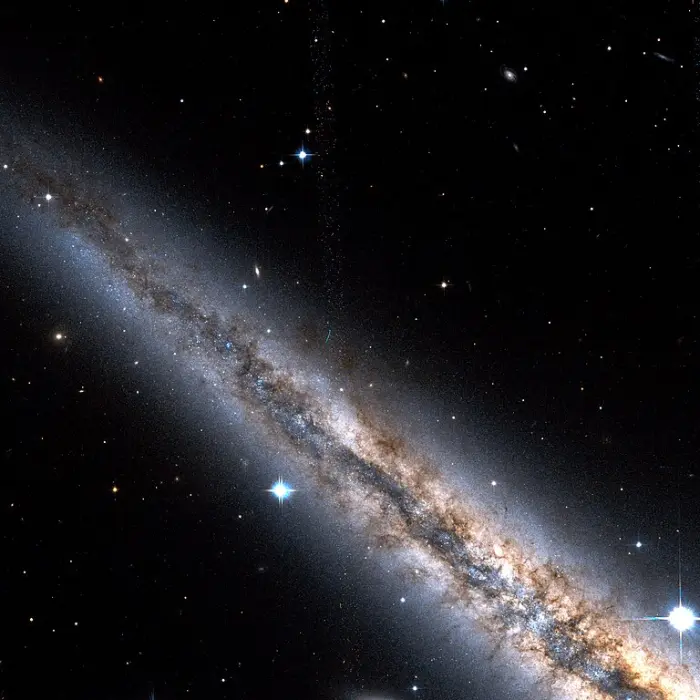
NGC 891 by the Hubble Space Telescope (HST), image credit: NASA/ESA, Hubble (PD)
Facts
NGC 891 was discovered by the German-born English astronomer Sir William Herschel on October 6, 1784.
The name Outer Limits Galaxy comes from the 1960s television show The Outer Limits. The Silver Sliver Galaxy was one of the galaxies shown in the series’ end credits, along with the Sombrero Galaxy (Messier 104) in the constellation Virgo, the Pinwheel Galaxy (Messier 101) and Bode’s Galaxy (Messier 81) in Ursa Major, the Andromeda Galaxy (Messier 31) in Andromeda, the Golden Eye Cluster (Messier 67) in Cancer, Centaurus A (NGC 5128) in Centaurus, and the galaxy NGC 1300 in Eridanus.
NGC 891 hosted a supernova discovered on August 21, 1986. Designated SN 1986J, the supernova shone at magnitude 14.
The Silver Sliver Galaxy was selected as the target for the first light image of the Large Binocular Telescope (LBT) at the Mount Graham International Observatory in Arizona. The image of the galaxy was taken on October 12, 2005.
In 2012, NGC 891 was the target for the first light image taken with the Large Monolithic Imager on the Lowell Discovery Telescope (LDT) at the Lowell Observatory in Arizona.
Location
The Silver Sliver Galaxy lies in the eastern part of Andromeda, near the border with Perseus. It appears in the region between Almach (Gamma Andromedae) in Andromeda and Algol (Beta Persei) in Perseus. The galaxy appears 3.5 degrees east of Almach. The open cluster Messier 34 in Perseus appears 3.5 degrees east of the galaxy.
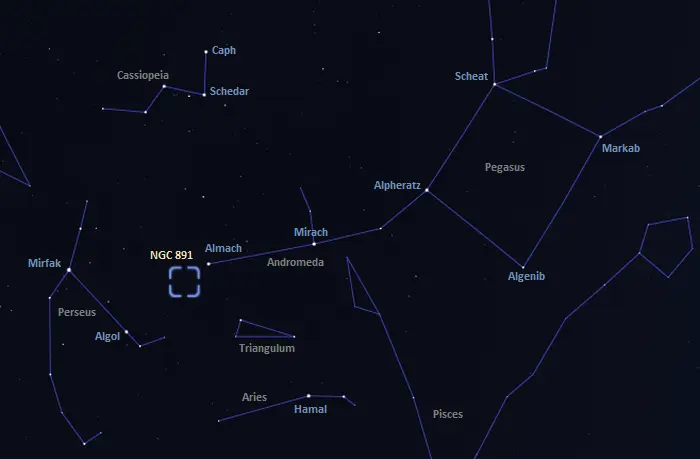
The location of the Silver Sliver Galaxy (NGC 891), image: Stellarium
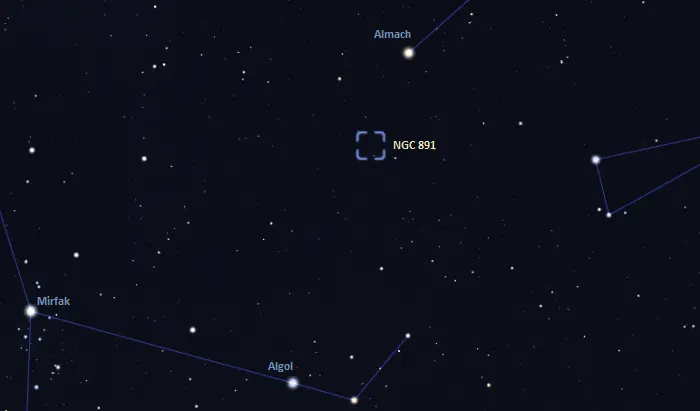
NGC 891 finder chart, image: Stellarium
The Silver Sliver Galaxy can be observed in small and medium telescopes, which reveal an elongated patch of light. Larger telescopes show the galaxy’s dark dust lane and bright nucleus. The galaxy’s brightness, relatively large size and prominent dark dust lane, combined with the bright foreground stars in the field of view of NGC 891, make the galaxy a popular target for astrophotographers.
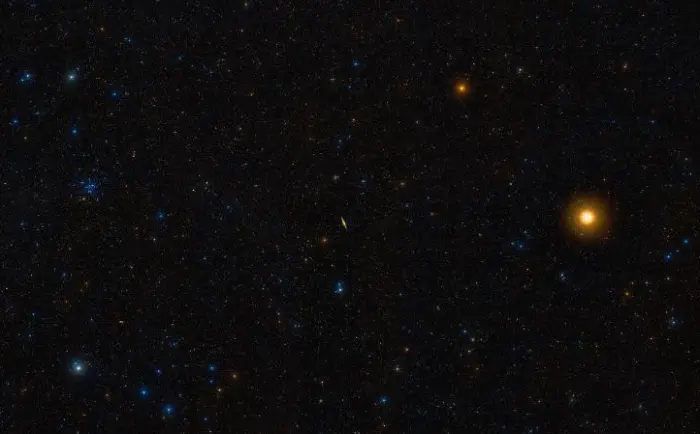
Almach (right) the Silver Sliver Galaxy (centre) and Messier 34 (left), image: Wikisky (DSS2)
The fainter galaxy cluster AGC 347 appears less than a degree from the galaxy. The galaxies in the cluster lie at about seven times the distance of NGC 891. Most of them are fainter than 14th magnitude.
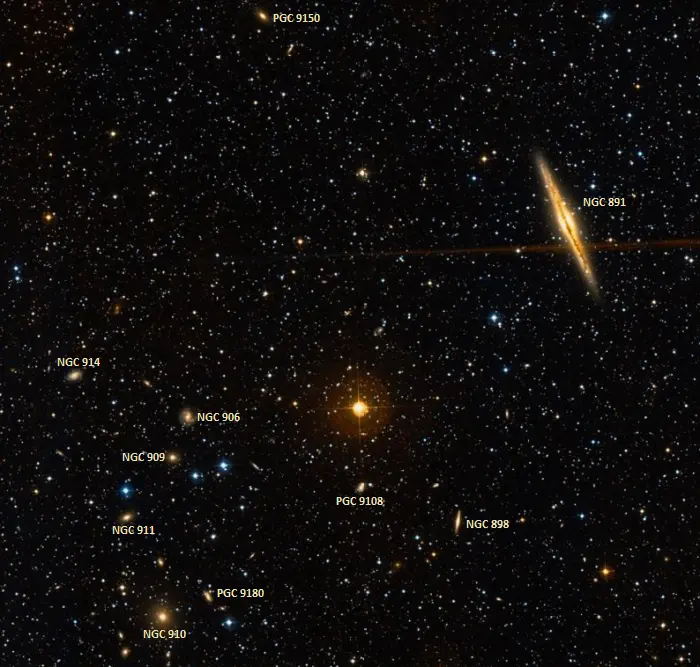
NGC 891 and nearby galaxies, image: Wikisky (DSS2)
The best time of the year to observe NGC 891 and other deep sky objects in Andromeda is during the month of November, when the constellation appears high above the horizon in the early evening. At declination 42° 20, the Silver Sliver Galaxy is visible from locations north of the latitude 47° S.
Silver Sliver Galaxy – NGC 891
| Constellation | Andromeda |
| Object type | Unbarred spiral galaxy |
| Morphological type | SA(s)b? |
| Right ascension | 02h 22m 32.907s |
| Declination | +42° 20′ 53-95″ |
| Apparent magnitude | 10.8 |
| Apparent size | 13′.5 × 2′.5 |
| Distance | 27.3 ± 1.8 million light years (8.4 ± 0.5 megaparsecs) |
| Redshift | 528 ± 4 km/s |
| Names and designations | Silver Sliver Galaxy, Outer Limits Galaxy, NGC 891, Caldwell 23 (C23), PGC 9031, UGC 1831, MCG+07-05-046, B3 0219+421, B3VLA 0219+421, BWE 0219+4207, 6C 021924+420732, 7C 021924.60+420736.00, GB6 B0219+4207, IRAS F02194+4207, IRAS 02193+4207, Z 0219.4+4207, ISOSS J02225+4221, JCMTSE J022233.0+422050, JCMTSF J022233.0+422050, TC 454, Z 538-52, TIC 293122165, 2MASS J02223247+4220494, 2MASX J02223290+4220539, MITG J022231+4220, MY 021923.8+420734.9, MY 021923.8+422113.3, PLCKERC -100 G140.41-17.39, WB 0219+4207, WN B0219.4+4207, UZC J022233.4+422102, VLSS J0222.5+4221, ZOAG G140.38-17.42 |
Images
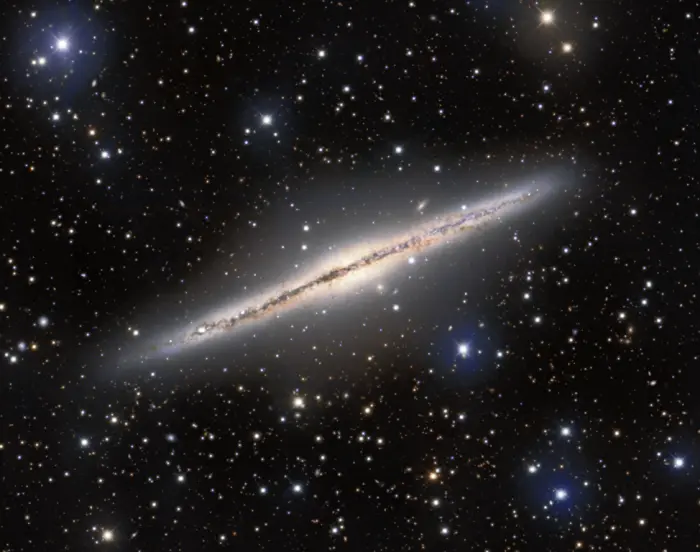
The Silver Sliver Galaxy — more formally known as NGC 891 — is shown in this striking image from the Mosaic instrument on the 4-meter Nicholas U. Mayall Telescope at Kitt Peak National Observatory, a Program of NSF’s NOIRLab. NGC 891 is a spiral galaxy that lies almost perfectly edge-on to us, leading to its elongated appearance and its striking resemblance to our home galaxy, the Milky Way, as seen from the Earth. Since NGC 891 is oriented edge-on, it’s great for investigating the galactic fountain model. When stellar winds and supernovae from the disk of a galaxy eject gas into the surrounding medium, it can create condensation that rains back down onto the disk. The condensed gas then provides new fuel for star formation. In addition to the portrait of NGC 891, this image is littered with astronomical objects near and far — bright foreground stars from our own galaxy intrude upon the view of NGC 891 and distant galaxies lurk in the background. Image credit: KPNO/NOIRLab/NSF/AURA; Acknowledgments: PI: M.T. Patterson (New Mexico State University); Image processing: Travis Rector (University of Alaska Anchorage), Mahdi Zamani & Davide de Martin (CC BY 4.0)
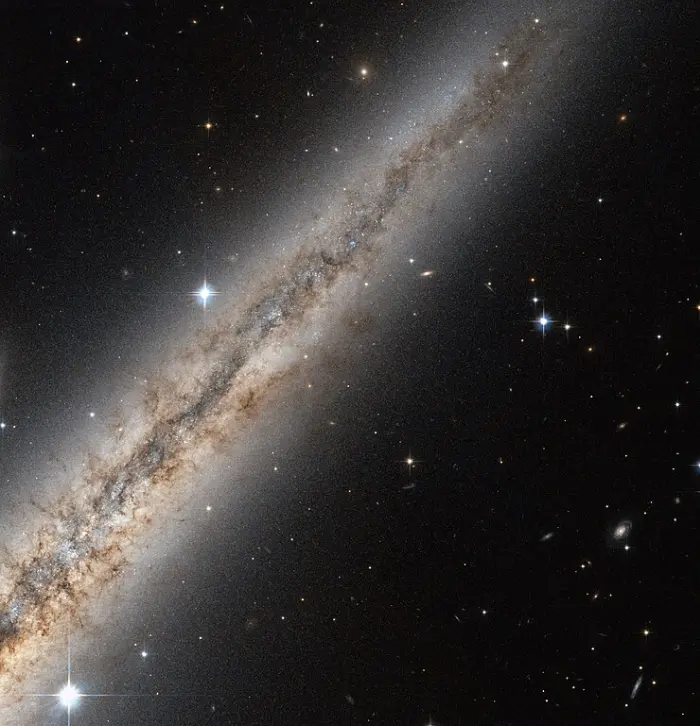
If we could travel across space and time to see our own galaxy from the outside looking in, it would probably look a lot like Caldwell 23. This spiral galaxy, also cataloged as NGC 891, is about 35 million light-years away from Earth in the constellation Andromeda. Sir Patrick Moore, creator of the Caldwell catalog, once said the full galaxy looks like “two fried eggs clapped back to back.” In this Hubble image, taken in visible and infrared light using the Advanced Camera for Surveys, the “yolk” portion of the galaxy is out of the picture beyond the lower left corner. A few foreground stars from the Milky Way shine brightly, while more-distant galaxies can be seen in the lower right corner of the image. Astronomers used Hubble’s observations of Caldwell 23 to learn more about the structure and evolution of spiral galaxies. One of their findings helped identify the source of Caldwell 23’s galactic “halo.” The halo surrounds the galaxy and primarily contains old stars, some of which are grouped together in large, sphere-shaped collections called globular clusters. The source of this halo material has been unclear, since theoretically it could either originate in the galaxy or be gravitationally pulled in from the area surrounding the galaxy. Scientists using Hubble found that Caldwell 23’s halo is similar in composition to other material in the galaxy, which suggests that the halo material was expelled from within the galaxy. Image credit: ESA/Hubble & NASA; Acknowledgement: Nick Rose (CC BY 2.0)
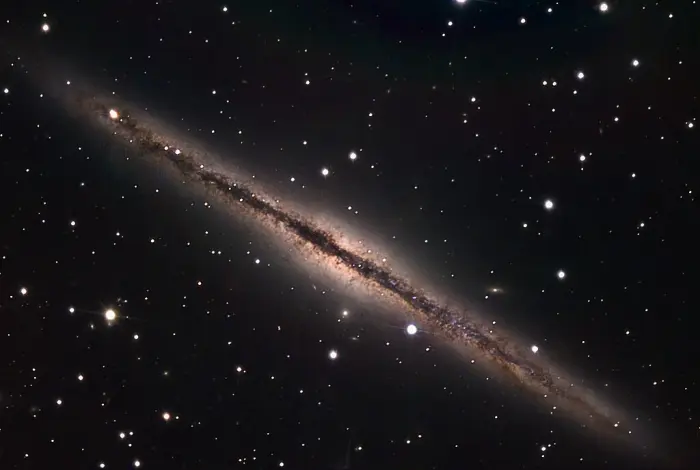
This galaxy in Andromeda is perhaps the most beautiful example of a nearby spiral galaxy viewed edgewise. Note the small companion galaxies above and beneath the disk. This particular galaxy is of interest to astronomers that study the dynamics of material in the galactic plane of spiral galaxies. In this example, there are sprays of material (gas and dust) that are being accelerated perpendicular to the disk. This effect is not well-understood. This image was taken as part of Advanced Observing Program (AOP) program at Kitt Peak Visitor Center during 2014. Credit: KPNO/NOIRLab/NSF/AURA/Dale Cupp/Flynn Haase (CC BY 4.0)